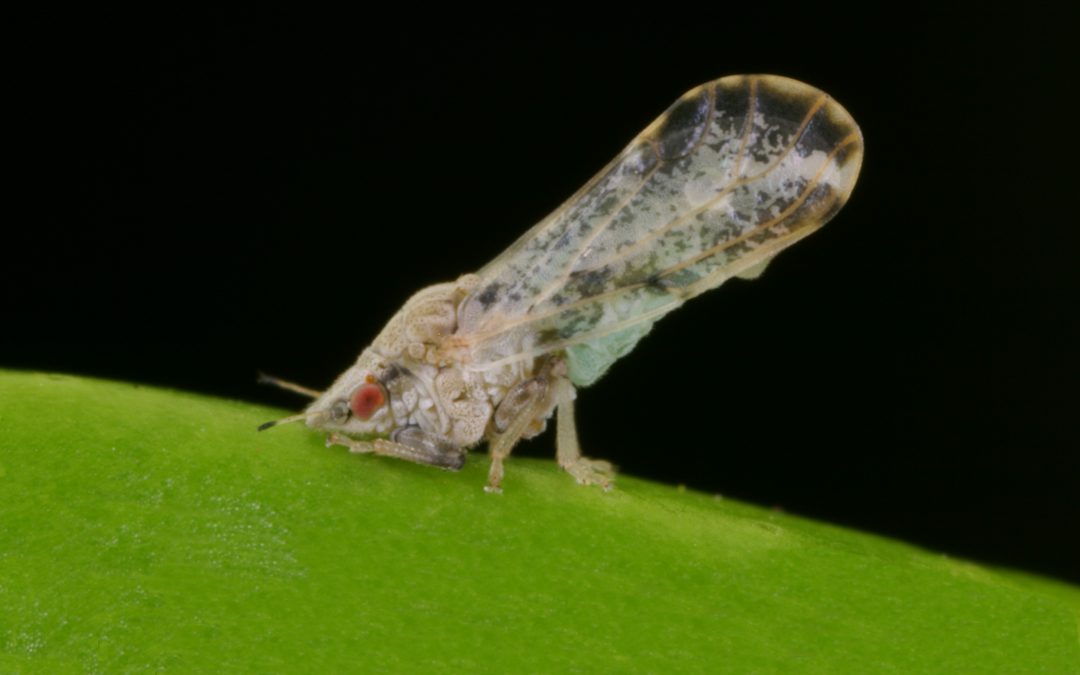
by Mark Tancig | Jan 13, 2022
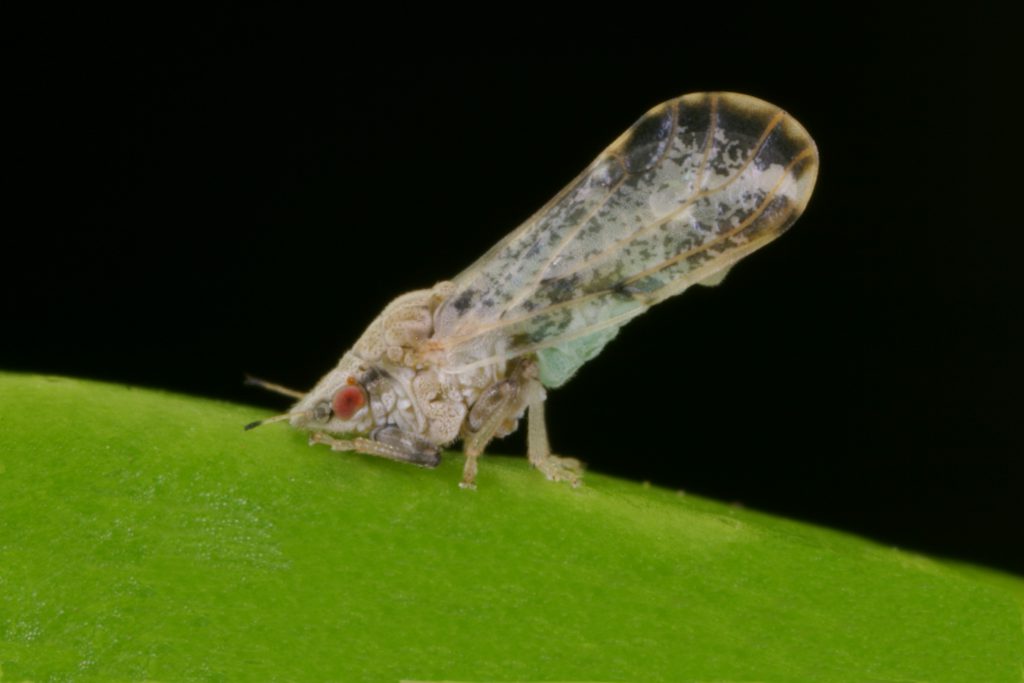
Asian citrus psyllid, Diaphorina citri. UF/IFAS/Entomology Photo: Michael Rogers.
In late 2016, as many of us were enjoying the harvests from our backyard citrus, a bacterial plant disease that can affect all citrus, citrus greening, was widespread in central and south Florida but had not made it this far north. That year, the vector, the insect that spreads the disease from tree to tree, had been found in Leon County and a few other surrounding Panhandle counties, but the disease had not. By mid-2017, the disease had been confirmed in Franklin County and we hoped that our cooler temperatures could keep the insect and disease at bay. Well, I regret to inform you that the disease has also now been confirmed in Leon County, growing in a residential yard in Tallahassee. Now that it is confirmed in non-coastal (and cooler) north Florida locations, I thought a review of the signs and symptoms – as well as what to do with your tree if you suspect or confirm greening – would be helpful.
The tricky part about diagnosing citrus greening is that it has symptoms that look very similar to soil nutrient deficiency symptoms, especially when first infected. This is a good time to mention that citrus require certain micro-nutrients for optimal growth and a citrus-specific fertilizer product should be used when applying fertilizer. Both the disease and certain nutrient deficiencies cause yellowing of the leaves. With greening, the yellowing is typically blotchy and/or not in any particular pattern. Nutrient deficiencies typically cause unique patterns of yellowing, such as a V-shape or artistic-like symmetrical patterns on each side of the leaf’s midvein. The soil’s acidity, or pH, can also cause some nutrients to not be taken up by the plant even if they are present. Soil testing, available from your local UF/IFAS Extension office, and scheduled fertilizations with a citrus-specific fertilizer can ensure that nutrients are not to blame for the discoloring of leaves. More advanced stages of the disease cause such symptoms as leaf drop, fruit drop, lop-sided fruit, uneven inner fruit cores, and reduced fruit quality.
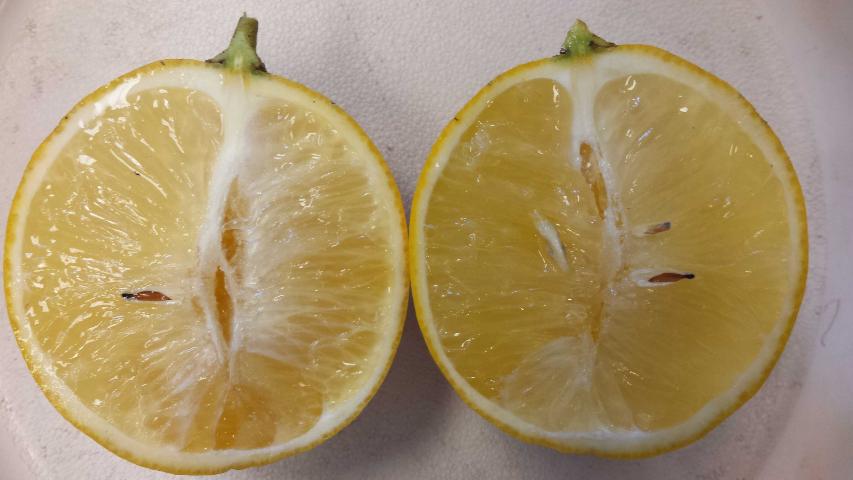
Citrus greening symptoms of the fruit. Photo by Brooke Moffis.
A more obvious sign of potential problems for your citrus are the presence of the insect vector, the Asian citrus psyllid. This is a tiny little insect that goes from one leaf to the other sucking up plant saps for food and unknowingly spreading the bacterium responsible for citrus greening. You can monitor for them by looking closely at the new flushes of growth. If the psyllids are present, you will likely notice most their small, peach-colored eggs and/or white, waxy secretions. If found, it doesn’t necessarily mean that your tree has greening, but you will want to minimize the chance that they could carry it to your tree. The psyllids can be treated with pesticides, ranging from the less harsh options (horticulture oils, neem oil, kaolin clay) to the more hardcore stuff (malathion, carbaryl, imidacloprid). Of course, always read the label of any pesticide before use and/or consult a qualified landscape professional for assistance.
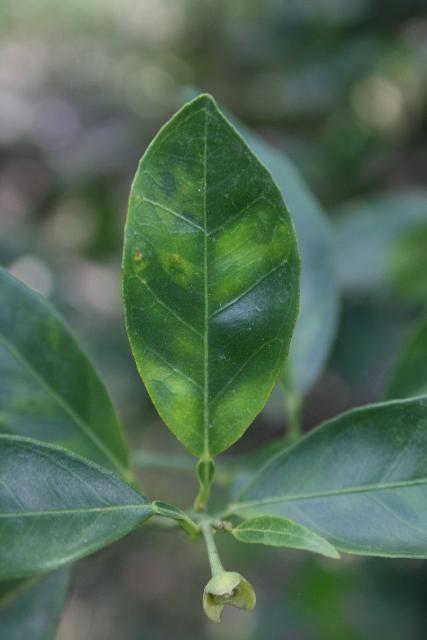
Blotchy leaf symptom of citrus greening. Photo by Jamie D. Burrow.
If you suspect your tree is infected, a diagnostic test can be performed by UF/IFAS plant pathologists at the North Florida Research and Education Center (NFREC) in Quincy to confirm. The test does cost $50, which may seem a little steep, but it’s an expensive lab analysis to run and may be worth piece of mind.
If citrus greening is confirmed in your tree, the right thing to do, unfortunately, is to remove and burn the plant material as there is no known cure. While the Florida Department of Agriculture and Consumer Services (FDACS) doesn’t have any removal requirements for infected dooryard citrus, tree removal is best to prevent additional spread of the disease to other trees, especially those grown by commercial producers in our area. This may seem drastic but eventually the health of the tree and quality of the fruit will decline to a point where you will want to remove it anyway. Don’t forget that movement of any citrus plant outside of the state is prohibited for the very reason of preventing spread of citrus diseases.
You may be asking, “Is it okay to replace it with another citrus tree?” The answer is yes you can, but you do risk re-infection and will want to be monitoring the new planting.
You may also be thinking, “What is going to happen to Florida citrus?” That’s a question that many researchers at UF/IFAS are trying to answer. There is some hope that intense irrigation and nutrient management, as well as specific pruning practices, can help infected trees continue to be profitable for commercial growers. Recently, UF/IFAS researchers were awarded several grants to try and figure a way out of this problem. Some of the lines of research focus on exploring the resistance found in different citrus varieties, including an Australian lime that appears to be greening resistant. This could potentially be used as a future rootstock. Another approach is to try and treat the plants with a particular peptide that would prevent the disease from binding in the insect’s gut. Isn’t that amazing?
Until a fix is found, we should be monitoring for this disease in our area and taking steps to reduce its presence through controlling the psyllids and removing infected trees. If you suspect a tree has greening, please contact your local county Extension office to review the symptoms and discuss your options.
Much more information on citrus greening is available at the following Ask IFAS website: https://edis.ifas.ufl.edu/entity/topic/citrus_greening and from this 2017 article – https://nwdistrict.ifas.ufl.edu/phag/2017/03/03/disease-alert-citrus-greening-and-asian-citrus-psyllids-found-in-the-panhandle/.
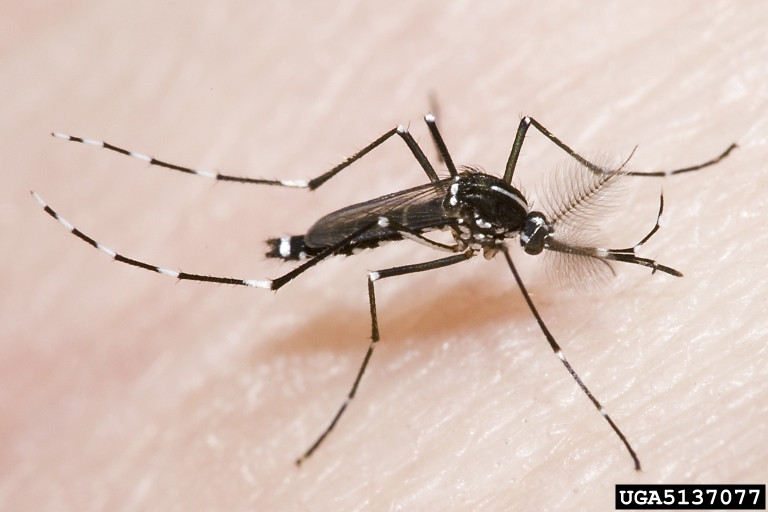
by Mark Tancig | Jul 29, 2021
Now that we’re getting plenty of rain and the temperatures are nice and toasty, our nemesis to enjoying the outdoors is back in full force. Yes, I’m talking mosquitoes, the reason for inventing window screens! If you’re gardening outside these days, you’ve probably been annoyed by one of the many mosquito species that occur in our area. Many of these mosquitoes are native species that play an important role in the food chain, feeding many aquatic and terrestrial wildlife, but some of them, like the daytime biting Asian tiger mosquito, are invasive species that were accidentally introduced. While mosquitoes are an important food source to more charismatic critters, they are annoying and can spread disease, and so we can benefit by reducing their presence.
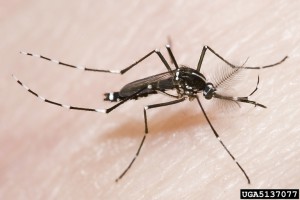
The Asian tiger mosquito, another annoying invasive species. Photo credit: Susan Ellis, Bugwood.org.
In addition to the age-old advice of draining any standing water, there are other control methods that can be very effective at reducing the mosquito population. One of the most effective and least-toxic options is the use of Bti products. These products come in granular or “donut” forms with the smaller granules being best for various uses around the home and the dunks/donuts for larger areas of standing water like ponds. These Bti products are considered a type of biological control since it is a species of bacteria, Bacillus thuringiensis israelensis to be precise, that causes mosquito, blackfly, and fungus gnat larvae to perish as they wiggle around and grow into their pupal stage. Because it only affects a narrow range of species, it is considered a selective pesticide that does not cause harm to non-target species, such as bees, birds, butterflies, frogs, lizards, and other desirable garden visitors. Bti can be sprinkled into rain barrels, bird baths, bromeliads, gutters, and other places where water may stand more than 5-7 days, the amount of time needed for mosquito eggs to develop into adults.
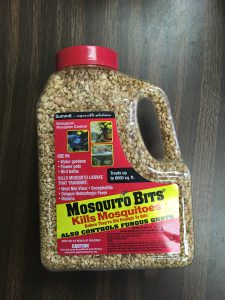
Bti granules prevent mosquito larvae from becoming biting adults. Photo by: Mark Tancig, UF/IFAS.
If considering other methods of mosquito control, such as the use of foggers, keep in mind that many of the pesticides used to control adult mosquitoes are not selective products and can kill the pollinators you may be trying to invite to your garden. Additionally, planting citronella plants, eating copious amounts of garlic, wearing repellent bracelets, or using ultra-sonic devices or cell phone apps has not been shown to repel mosquitoes so stick to what is known to work.
For a more enjoyable mosquito season, keep the window screens tight, wear long pants and sleeves and use appropriate repellents when outdoors, and do your best to minimize standing areas of water. If you have questions about mosquitoes and their control, visit the UF/IFAS Florida Medical Entomology Lab website (https://fmel.ifas.ufl.edu/) and browse the many resources available.
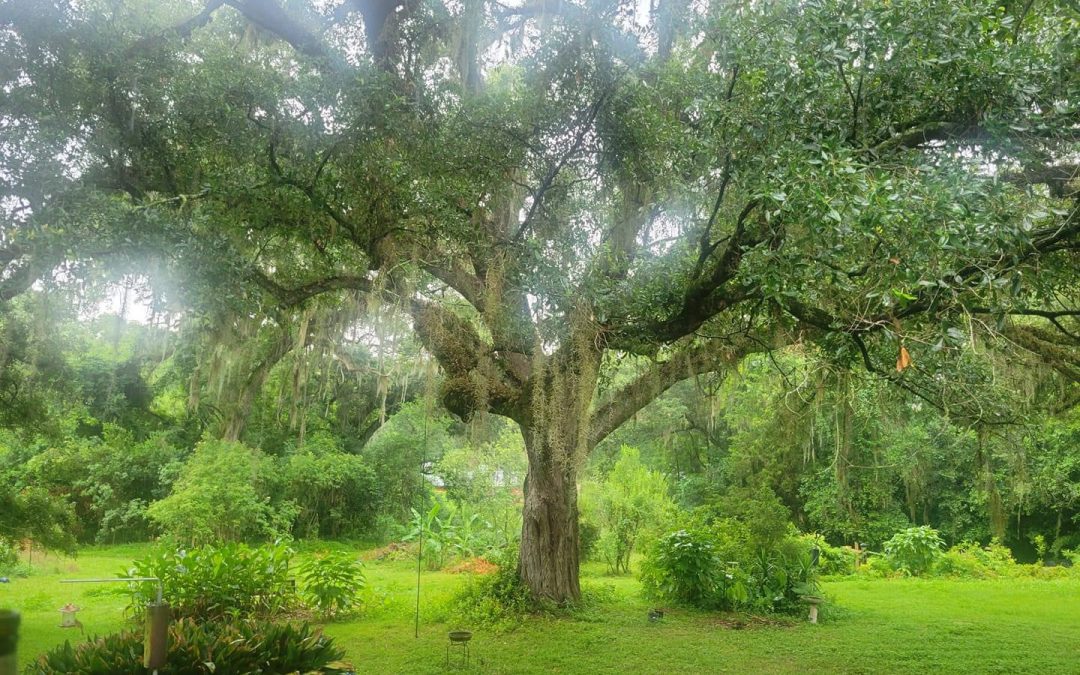
by Mark Tancig | Jun 17, 2021
Spending time outdoors during the Florida summer is not for the faint of heart. It’s hot! And it’s humid! Just moving around outside for a moment in the early morning causes you to break out in a sweat. Most evenings, even after the sun is low in the western sky, but there’s still enough light to enjoy the outdoors, the sweat doesn’t stop. A Floridian’s only hope is that nearby, there is a large shade tree to take cover under. In north Florida, there’s nothing more inviting than a huge live oak draped in Spanish moss for a drink of ice water and a slight breeze. If you don’t have such a spot, start thinking about planting a shade tree this winter!
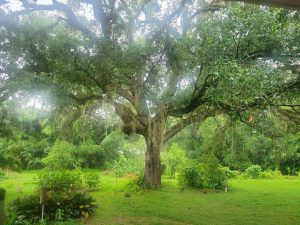
A large live oak is great for shade! Credit: Dawn Reed.
In north Florida, we have many options to choose from, as we live in an area of the United States with some of the highest native tree abundance. Making sure you get the right tree for the right place is important so make a plan. Where could this tree go? Is there plenty of space between the tree and any structures? You’ll want to give a nice shade tree plenty of room – 20’ to 60’ away from structures and/or from other large trees – to grow into a great specimen. Be sure not to place a large tree under powerlines or on top of underground infrastructure. You can “Call 811 before you dig” to help figure that out. If space is limited, you may want to consider trees that have been shown to be more resilient to tropical weather. Also try and place the tree in a way that provides added shade to your home. Deciduous trees planted along your home’s southeast to southwest exposure provide shade during the summer and let in the sun during the cooler winter. However, be careful that the tree doesn’t grow to block the sun from your vegetable garden!
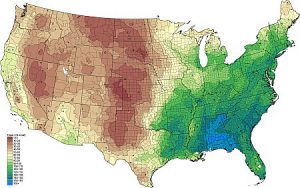
A density gradient map of native trees in the US. Notice where the highest number occur. Credit: Biota of North America Program.
Here are some ideas for shade trees, those trees that are tall (mature height greater than 50’) and cast a lot of shade (mature spread greater than 30’). All of these are native trees, which have the added benefit of providing food and shelter to native wildlife.
- Red maple (Acer rubrum)
- Pignut hickory (Carya glabra)
- Green ash (Fraxinus pennsylvanica)
- Tulip poplar (Liriodendron tulipifera)
- Southern magnolia (Magnolia grandiflora)
- Sycamore (Platanus occidentalis)
- Shumard oak (Quercus shumardii)
- Live oak (Quercus virginiana)
- American elm (Ulmus americana)
It’s best to plant during the winter and follow good planting practices.

Even with this young sycamore, you’ll be made in the shade. Credit: UF/IFAS.
While it may take a while for you to relax under the shade of your tree, they can surprise you in their growth and, as they say, there’s no time like the present. If you have questions on selecting or planting shade trees, contact your local UF/IFAS Extension office.
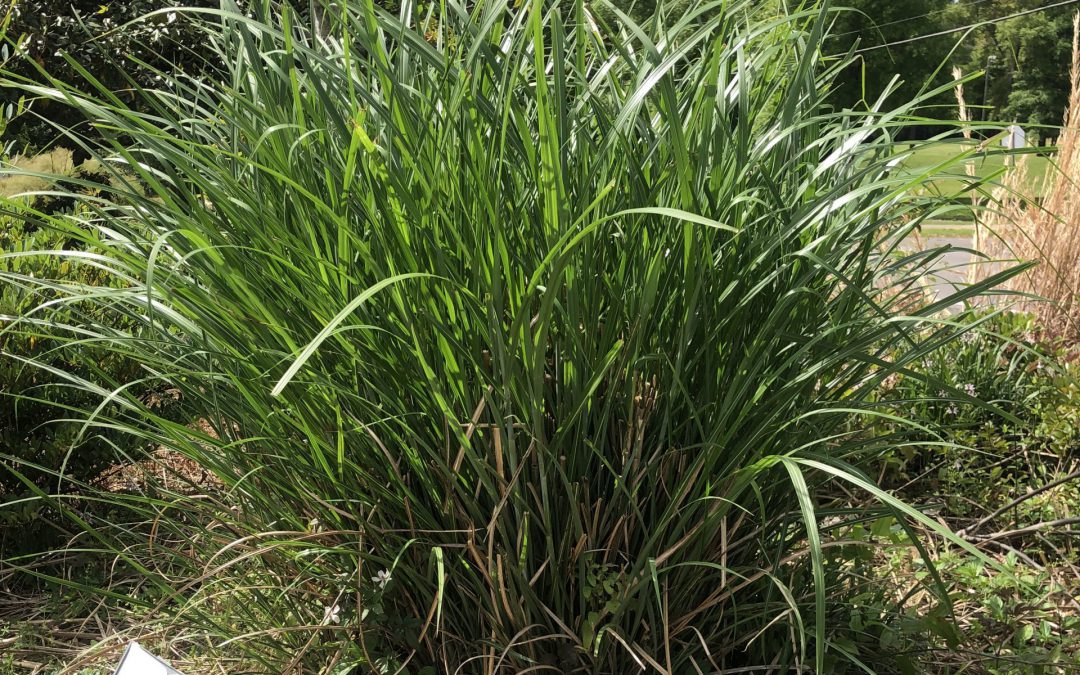
by Mark Tancig | Apr 8, 2021
Ornamental grasses are a great addition to the landscape. Most are usually easy to establish, need little water and fertilization, provide different textures, and are generally low maintenance. The one main maintenance activity that is necessary for most of our north Florida ornamental grasses is a good “haircut” in the spring.

Ornamental grasses for north Florida, such as muhly grass, purple fountain grass, and Miscanthus (l to r), add texture, color, and winter interest to a landscape. Credit: UF/IFAS.
Pruning grasses removes the spent flowers and seed heads, as well as all of the brown leaves, which provided the fall and winter interest that ornamental grasses bring to the landscape. These leaves also serve as a sort of natural wind-chime during the cold, windy days of our winters and may even provide cover and nesting material for wildlife. However, now it’s spring, and lush green growth is waiting to pop through that dead mix of leaves and stems. Pruning clears all that out, allowing for good air movement and a rejuvenation of the plant that can help minimize pests and disease.
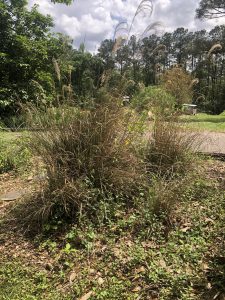
Miscanthus grass before a spring “haircut”. Credit: Mark Tancig, UF/IFAS.
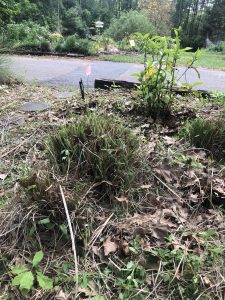
Miscanthus grass after a spring “haircut”. Credit: Mark Tancig, UF/IFAS.
To prune ornamental grasses, wait for after the last average frost date and grab some nice sharp shears. Next, just shear the clump about six inches above the soil line working from the outside towards the center with a slight angle, creating a sort of fade effect. For larger specimens you may need to adjust the cut a bit higher and may even want to use a hedge trimmer. Nice clean cuts are preferred.
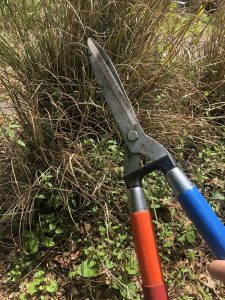
Shears are the way to go when pruning ornamental grasses. Orange and blue handles optional! Credit: Mark Tancig, UF/IFAS
One good pointer I saw online is to also bring along an old belt or a piece of rope to cinch up the dead material before pruning to easily collect the debris. I tend to use a cut and swipe motion that pushes the large material to one side of the plant, and I follow up with a metal garden rake to pull out more of the old, coarser material.
Within no time, new growth will flush out from the mound and often surprise you with how quick it can grow. This proves just how dynamic ornamental grasses can be in the landscape, showcasing lush green growth during one season and providing stark, whimsical interest during another.
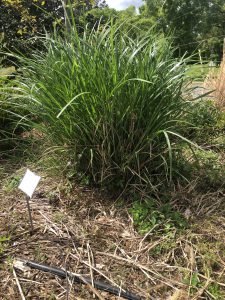
Miscanthus grass two weeks following pruning. Credit: Mark Tancig, UF/IFAS.
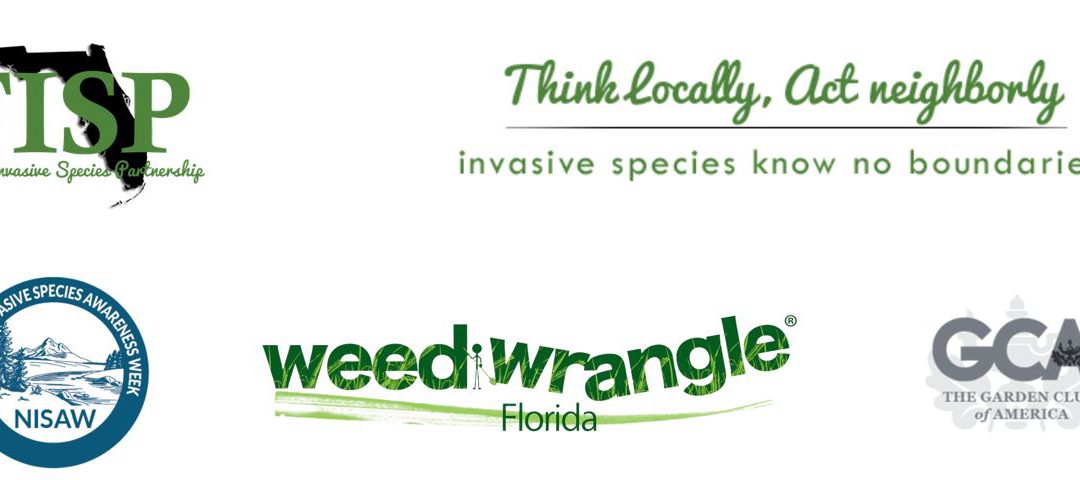
by Mark Tancig | Feb 25, 2021
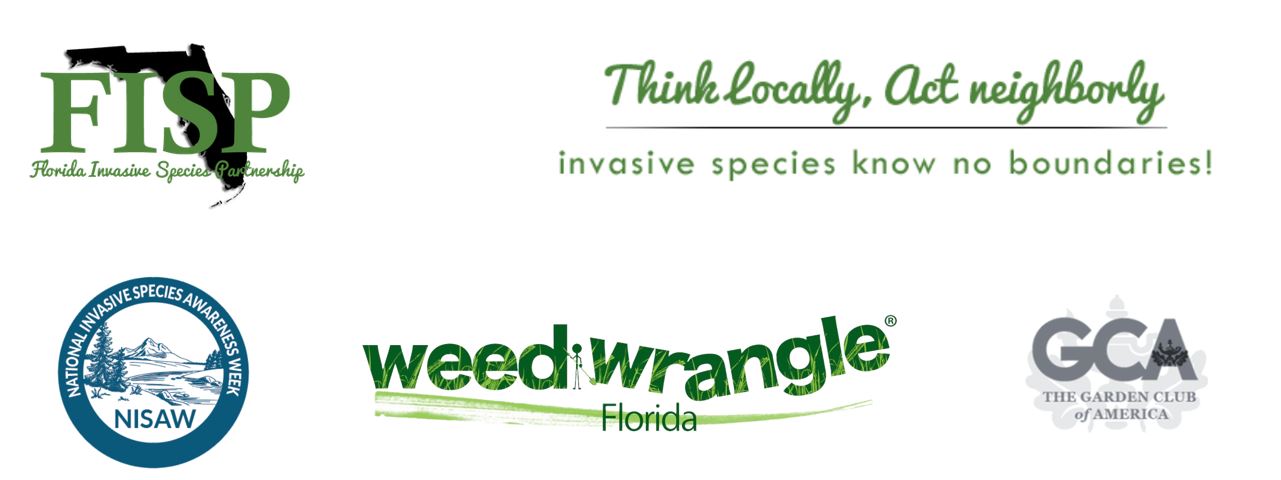
February 22-26, 2021 is National Invasive Species Awareness Week.
February 22 to 26, 2021 is National Invasive Species Awareness Week (NISAW). This is a time where many organizations involved with land management and conservation will be sharing information to educate the public about the issue of invasive plant and animal species. Living in Florida, we should all be well aware of the concerns with invasive species as we have experience with many, including the fire ant, kudzu, iguanas, climbing fern, and pythons. Oh my! Due to Florida’s climate and our many active ports, we are prime for introductions of many non-native species. These invasive species alter our unique ecosystems and can cause harm to us humans by blocking waterways (aquatic plants like Hydrilla), affecting our health (allergenic plants like Chinese privet) and the health of our pets and livestock (dogs allergic to tropical dayflower and cattle killed by Nandina). Since many of these pests were brought here for the ornamental landscape trade, gardeners have a responsibility to be aware of these invasive species and do what they can to control them.
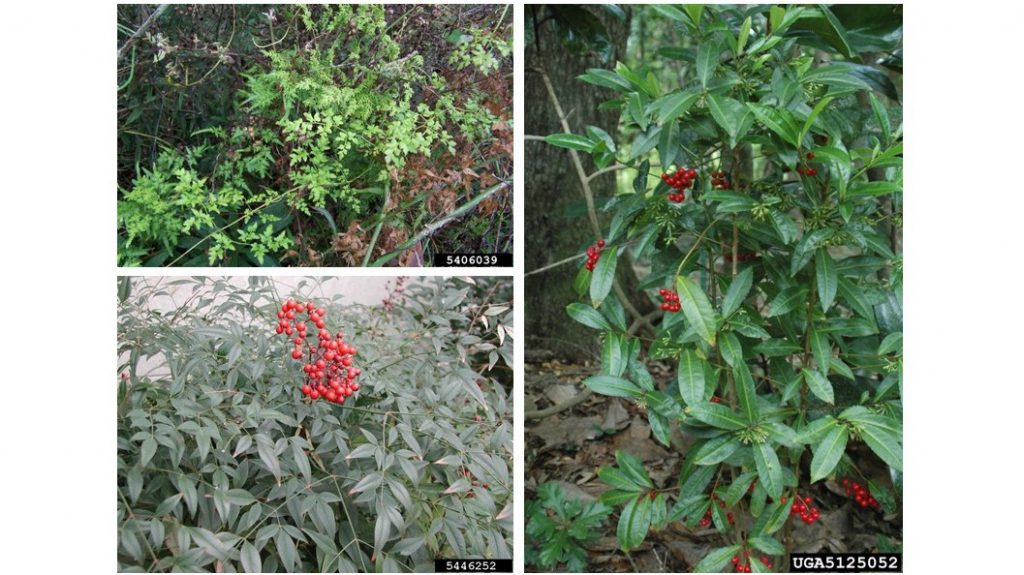
A few of the most common invasive species you may find in your north Florida landscape. Clockwise from top left – Japanese climbing fern, coral ardisia, and heavenly bamboo. Image Credit: Bugwood.org
There are several great resources from UF/IFAS to help with identification and control of invasive species, from your local county extension agents to a slew of online publications and websites. This year, the Florida Invasive Species Partnership (FISP), of which UF/IFAS is a partner, is coordinating a pandemic-safe, stay-at-home Weed Wrangle to encourage Floridians to work on controlling invasive species. If you share your efforts, you’re eligible for prizes, including weed pullers and gift certificates for native plants! For more information, check out the website for the Florida Weed Wrangle Week event – https://www.floridainvasives.org/flwww.cfm.
For more help identifying and controlling invasive species, contact your local county extension office or visit this UF/IFAS website that is a clearinghouse of invasive species information – https://sfyl.ifas.ufl.edu/natural-resources/invasive-species/.




















